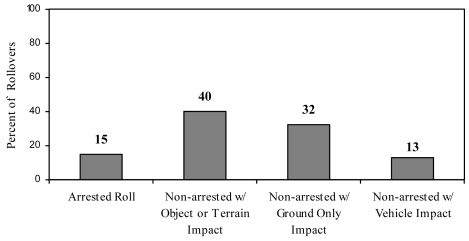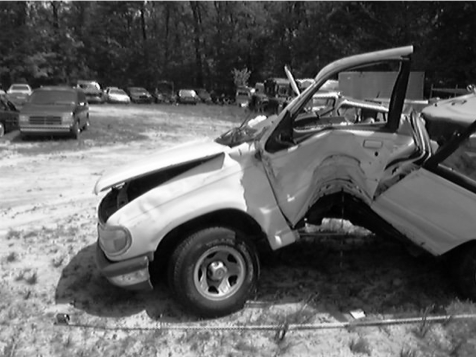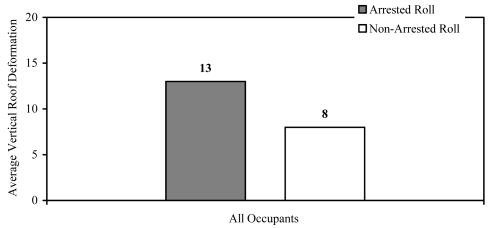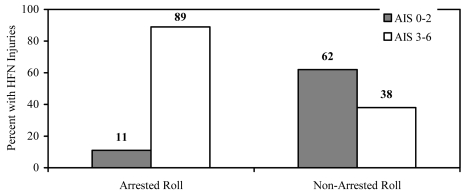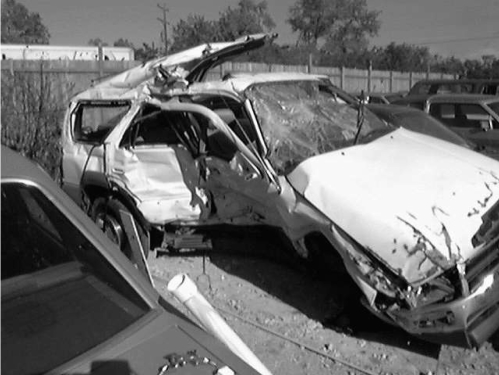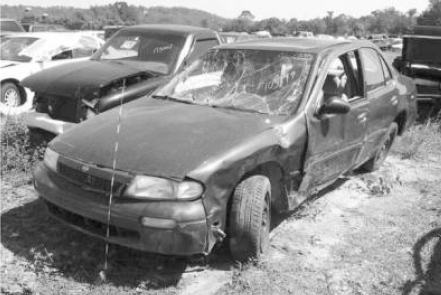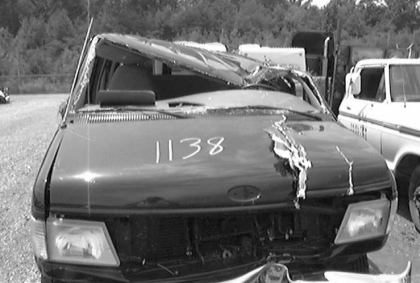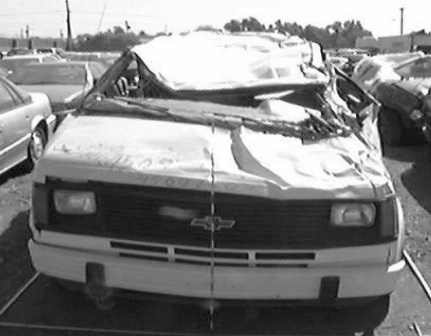Abstract
National Automotive Sampling System (NASS) crash statistics were examined to understand injury patterns of belted occupants in rollover crashes and determine accuracy/completeness of selected NASS-coded variables. A comprehensive statistical study, followed by detailed engineering reviews of 278 NASS cases, is in progress. The primary objective is to understand rollover crash characteristics and their influence on rollover injury severity. Focus was on cases with “roof contact” as the injury source. Two groups— significant roof deformation with no injury, and significant injury with minimal roof deformation—are discussed, as are crash characteristics such as “arrested roll.” Also, based on evaluation of existing NASS codes, recommendations are made to enhance NASS coding of rollover-related variables.
Relationships between vehicle roof strength, roof deformation, and occupant injury during a rollover crash are complex, and understanding these has been and remains a critical research issue. In the past two decades, a number of in-depth accident investigations and analyses of occupant injury mechanisms in rollovers have been published. One of the most valuable data sources for field data, relied upon by some of the studies cited, has been the National Automotive Sampling System/Crashworthiness Data System (NASS/CDS). This file, maintained by the National Highway Traffic Safety Administration (NHTSA), has a wealth of information on crash/vehicle/occupant and injury factors associated with rollover crashes to address injury patterns in rollovers.
BACKGROUND
Understanding rollover crashes has become an important issue for auto-safety researchers and safety organizations. To solicit information from the public, NHTSA has set up a docket (NHTSA-1999–5572) specifically to address the Federal Motor Vehicle Safety Standard 216, “Roof Crush Resistance,” which was applied to passenger cars in 1973 and extended in 1994 to all light vehicles. This docket has submissions ranging from complex statistical arguments to vehicle test data and engineering analyses evaluating the relationship between roof performance and rollover injury. Because many of these studies are based on NASS/CDS field data, it is important to understand NASS coding procedures and determine whether detailed NASS case data can be used to develop additional variables for identifying rollover crash characteristics. In addition, NHTSA relies on NASS/CDS data to provide estimates of rollover injuries, and thus a thorough understanding of NASS codes is warranted to assess the accuracy of these estimates. Finally, NASS/CDS teams must be informed of the importance of enhancing/refining rollover-related variables so that the safety community can use NASS data to its full potential.
LITERATURE OVERVIEW
Since the 1970s, a large body of technical literature has been published on association and/or causation of occupant injury in rollover crashes, focusing on roof deformation.
From the earliest analyses [Huelke et al., 1972; Huelke and Compton, 1983; Mackay and Tampen, 1970; Plastiras et al., 1985; Strother et al., 1984], tests [Orlowski et al., 1985; Bahling et al., 1990], and simulations [Sakurai and Isenlo, 1991] to more recent studies [Padmanaban et al., 2005; Moffatt et al., 2003; James et al., 1997; Piziali et al., 1998; Lund et al., 1999; Moffatt and Padmanaban, 1995], researchers have examined—through testing, engineering, and statistical analysis—whether a relationship exists between roof crush and rollover injury. In addition, several statistical studies in the past decade have used NASS/CDS data to examine rollover crash characteristics and their influence on occupant injury [Digges and Eigen, 2003; NHTSA, 2003; Malliaris and Deblois, 1991; Najjar, 1981].
This paper adds to this body of research by reporting some of the results from a detailed two-phase study (Phase 1: statistical study; Phase 2: engineering review) of rollover cases. Results for the Phase 1 study are publicly available in the NHTSA Roof Crush Resistance docket [Padmanaban, 2004].
STUDY OVERVIEW
In 2004, the team of JP Research, Inc., Ivy Consultancy LLC, and KEVA Engineering LLC undertook a comprehensive two-phase study, for the Alliance of Automobile Manufacturers (Alliance), of rollover injury experience in the United States. This study does not address injury causation, which can be addressed only through accident reconstruction and detailed biomechanical analyses studying occupant motion during roll. Rather, the objective was to use the NASS/CDS statistical data and a detailed review of publicly available rollover case data to examine occupant injury patterns and crash factors associated with rollover crashes.
In Phase 1, NASS/CDS data from 1988 through 2002 was analyzed to develop an accurate statistical estimate of the number of belted occupants with serious (AIS1 3–6) head/face/neck or torso injury in rollovers through various injury sources [Padmanaban, 2004]. A major finding was that NHTSA’s statistical estimate of the number of “roof contact” injuries was inflated [NHTSA, 2001].
In Phase 2, a companion analysis has been undertaken utilizing additional, detailed information from scene diagrams, injury sketches, and photographs for 1997 through 2001 NASS/CDS rollover cases available online. The Phase 2 objectives include identifying various crash characteristics associated with occupant injury in rollovers and examining the accuracy and completeness of some NASS-coded variables. In addition, the study has resulted in development of a set of recommendations for NASS teams to implement in order to facilitate more comprehensive rollover injury research using field data.
STUDY OBJECTIVES
The key objectives of Phase 2 study are to:
Understand the injury patterns for belted occupants in rollover crashes;
Examine different types of rollover crash characteristics using case review;
Using the detailed case files, examine the accuracy and completeness of selected NASS codes including belt use, number of quarter turns, direction of roll, and magnitude of roof deformation at position;
Develop recommendations to improve/enhance NASS coding of rollover-related variables to permit more comprehensive rollover safety research;
Examine NASS data for rollover crashes resulting in serious injuries where the injury source is coded by the NASS team as “unknown”;
Identify methods to apply the insight gained from detailed case review to refine statistical calculations using the entire NASS weighted data; and
If detailed case data permits, develop additional qualitative variables reflecting roll energy/roll distance/roll direction to help understand rollover crash severity.
This paper presents the methodology used and key findings for analyses conducted in pursuit of some of these objectives.
METHODOLOGY
The Phase 2 study focused on review of all rollover cases with seriously injured occupants coded as “injury source–unknown” (for the years 1997–2001) and a selection of rollover cases with injury sources identified. A total of 278 cases (309 occupants) were reviewed.
STUDY CRITERIA
The criteria for inclusion began with the requirements of a rollover crash, from NASS data files for 1997 to 2001, in which the crash-involved vehicles were 1990 and later model cars and light trucks. In addition, cases were selected on the basis of:
Belt use (primarily belted occupants)
Ejection status (non-ejected or partially ejected)
Injury source (particularly “roof contact” or “unknown”)
Injury severity (majority are AIS 3–6 head/face/neck or torso injury)
Roof deformation at occupant position (full range).
All the combinations of injury severity/roof deformation categories were included in the study dataset (Table 1).
Table 1.
The Four Basic Crash Types Reviewed
 |
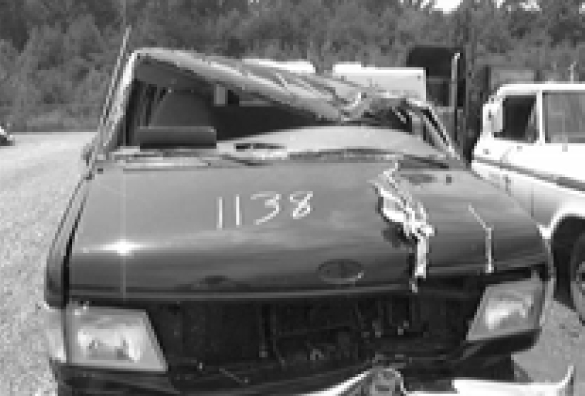 |
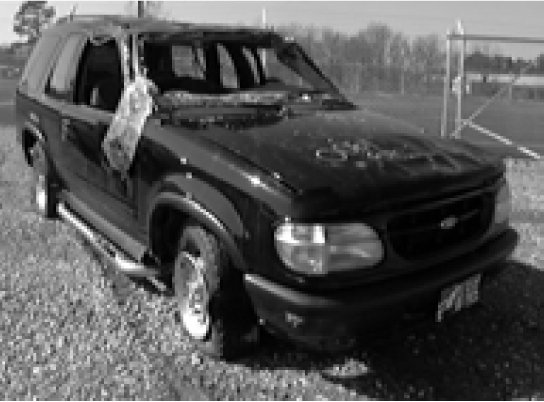 |
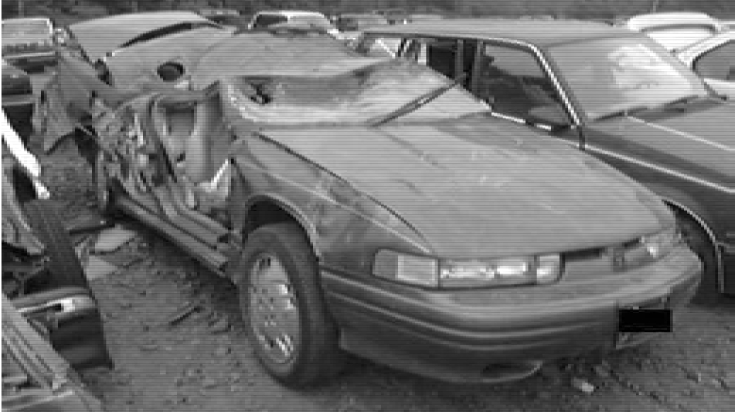 |
RESEARCH TOOL
To facilitate the in-depth review process for such a large number of cases (278) and variables of interest, an extensive research tool was developed that allows NASS photos of crash vehicles, diagrams of the crash scene, and information on occupant injury/contact and about 150 key NASS variables to be stored, sorted, and searched in one convenient file.
The NASS case files that are available on NHTSA’s website for the years 1997–2001 have multiple layers of HTML files embedded together for each case, making a concurrent review of case material—vehicle photos, injury sketches, scene diagrams, and other NASS-coded information on over 150 variables—extremely difficult and time consuming under the current NASS setup. The research tool developed by JP Research permits concurrent review of all the information pertinent to a study of rollover crashes.
In addition to the available NASS data, photos, and coding sheets, the study team included the following information after review of each case:
Number of quarter turns, amount of roof deformation, partial ejection, direction of roll, and belt use;
Variables identifying the characteristics of rollover (rollovers with fixed object contact, arrested rolls, etc.); and
Qualitative variables identifying various aspects of rollover crash characteristics.
ANALYSES
Three analyses performed by the study team are presented in this paper:
Examination of cases with injury source “unknown,”
Review of selected NASS variables, and
Identification of rollover crash characteristics.
Injury Source “Unknown”
One of the objectives in Phase 2 was to review the rollover cases included in the NASS data for which the injury source was coded as “unknown” to understand the circumstances and to see whether any additional information can be obtained from photographs, scene diagrams, or other information included in detailed NASS case files. For the 1997–2001 NASS data, there were 185 seriously injured occupants in rollover crashes coded as injury source “unknown.” All of these cases were reviewed.
Review of Selected NASS Variables
The study team evaluated coding reliability and accuracy for selected NASS-coded variables typically used in analyses of rollover crashes. Because these variables—including such frequently used driver and crash factors as belt use, ejection status, magnitude of roof deformation, and number of rolls—are significant to understanding injury patterns in rollover crashes, it is important to obtain insight into the validity and completeness of NASS coding procedures.
Rollover Crash Characteristics
All available NASS cases for the years 1997–2001 meeting the study criteria were reviewed, and the study team developed additional rollover variables to characterize rollover events. The selected dataset includes a higher percentage of severely injured occupants (AIS 3–6) than annual estimates derived for the entire NASS dataset.
RESULTS
This section presents the results for three analyses performed by the study team. At the end of this section, some examples addressing rollover crash characteristics and injury patterns are presented.
INJURY SOURCE “UNKNOWN”
For this category, 160 cases involving 185 occupants were available, and all of these cases were reviewed. Of these occupants, 14 were seriously injured, with injury sources identified by NASS for serious injuries but not for the minor injuries sustained by the same occupant. For 149 occupants, no injury source was identified for any injury (minor or severe). Of these, 95 were in vehicles for which no vehicle inspection had been performed by NASS teams, and consequently no information about injury source was available; the other 54 were in vehicles for which complete or partial vehicle inspection had been performed, but for which very limited data was available on occupant contacts. For the last 22 occupants, it was not clear whether vehicle inspection had been performed, but no data on occupant contacts was available.
Since for many of the “unknown” cases there is no information available in NASS to facilitate any conclusions on injury sources, it is misleading to arbitrarily distribute these between known injury sources for analytical purposes. This is especially true when national estimates are derived using data on injury sources for rollovers.
REVIEW OF SELECTED NASS VARIABLES
One of the objectives of the study was to evaluate selected NASS-coded variables used to understand rollover crash characteristics. Overall there was good agreement between team’s assessment and NASS values for all the variables examined, as seen below:
Belt use – 98%
Ejection status – 97%
Direction of roll – 93%
Quarter turns – 90%
Magnitude of roof deformation – 88%
A few observations on some key rollover variables are presented in this section.
Belt Use
An important variable to assess the injury experience of occupants is belt use. Detailed review of the 124 occupants in the study cases shows that there was 98% agreement between NASS-coded belt use and the study team’s assessment of belt use in cases with sufficient data for analysis. There were a very few (3) cases where NASS had coded an occupant as “belted” and the study team concluded, based on interior occupant contacts that were inconsistent with restraint use, that the occupant was “not belted.” Overall, there was no significant error in belt use reporting for the 124 occupants studied.
Number of Quarter Turns
One possible indicator of crash severity is number of quarter turns [Padmanaban, 2004]. The NASS coding of quarter turns was compared to the study team’s assessment using the detailed individual case data, and a few observations were made:
Of the cases with known NASS values, there was about 90% agreement between the NASS codes and the study team’s assessment.
There were five cases where a vehicle went through a few quarter turns forward and then rolled back and was coded to the rest position of the vehicle. For example, a vehicle that rolled three quarter turns, but was on its roof at rest, was coded as two quarter turns (i.e., NASS underestimated the number of quarter turns).
For ten cases NASS coded as “unknown”, the study team was able to estimate the number of rolls using detailed case data, including photographs and scene diagrams.
In general, there was no significant disagreement between known NASS codes and the study team’s assessment on number of rolls.
Magnitude of Roof Deformation
The study team examined the accuracy of “magnitude of roof deformation” identified by NASS investigators. Overall, the results showed about 88% agreement between the NASS-coded range for vertical roof deformation at the occupant’s seated position and the study team’s assessment of actual deformation. In addition, no inherent biases were found in the direction of magnitude for the cases where there was disagreement. However, these findings require some discussion.
Although roof deformation is available in precise units in the detailed NASS case data, the NASS teams use wide ranges to identify roof deformation (1–3 inches, 3–6 inches, 6–12 inches, etc.) in the electronic file. Two types of checking were performed for this variable. First, a comparison was made between precise units available in detailed cases and the ranges provided in the electronic files. Second, to determine whether the cases were evenly distributed within the ranges, the study team used the detailed data to compare the distribution of cases identified by NASS for each range (e.g., for the 6–12 inches category, the number of cases with 6 inches of roof deformation, 7 inches, 8 inches, etc.). This comparison was important to assess the validity of using an average magnitude of roof deformation for each category. The cases for each range were found to be evenly distributed within each range.
In five cases coded by NASS as intrusion, the individual coded deformation value included in the detailed case file is negative, but the magnitude of deformation was then coded in the range that corresponds to the absolute value of the individual deformation (i.e., -12 inches of intrusion becomes a “12–18 inch” magnitude of deformation).
In the ten cases that showed significant difference between NASS-coded values and the study team’s assessment, most were overestimated by NASS.
It should also be noted that deformation variables for cases with no roof deformation and unknown roof deformation are left blank in the original NASS files. This could lead to erroneous results when the data is analyzed. Procedures to separate the “no roof deformation” cases from “unknown roof deformation” cases were developed by the study team.
Based on the review of NASS-coded variables and the study team’s assessment, a set of recommendations to enhance NASS rollover coding were developed. These are presented at the conclusion of this paper.
ROLLOVER CRASH CHARACTERISTICS
The study team developed additional rollover variables to characterize rollover events. These included rollover class (arrested/non-arrested), a roll distance category, a roll dissipated energy category/indicator, and details on objects contacted.
Rollover Class
Rollovers were classified as arrested and non-arrested rolls, as follows:
Arrested rolls— in which the rollover is stopped abruptly by impact with a fixed object.
Non-arrested rolls with object or terrain impact— in which the vehicle impacts one or more fixed objects or terrain factors (ditch, change in grade, etc.) before, during, or after the roll, but is not abruptly stopped by the impact (e.g., hit a tree, hit a pole, and rolled; or vertical drop, down embankment, and rolled).
Non-arrested rolls with vehicle impact— in which roll occurs subsequent to impacting or being impacted by vehicles.
Non-arrested rolls with ground-only impact— in which no vehicles, nor objects other than the ground, are impacted during the rollover sequence.
Figure 1 presents the distribution of rollovers, by rollover class, for the study set.
Figure 1.
Rollover Characteristics (Phase 2 Study Dataset)
Arrested Rolls
In an arrested roll, the rollover sequence is interrupted or stopped by an impact by any part of the vehicle with a fixed object (e.g., hit a curb, rolled, hit a tree). Approximately 80% of arrested rollovers in the study cases were arrested by impact with a tree or pole. This event has a significant influence on the loads applied to the vehicle structure and on the severity of occupant injuries. As can be seen from Figure 2, changes in geometry resulting in deformation into the passenger area at the point of impact (in this case, through the side/bottom of the vehicle after rollover was arrested by contact with a tree) can be severe and can make any resulting or incidental roof deformation irrelevant as an injury source. This is problematic since a simple statistical review would pick this up as a fatal rollover with roof crush, implying an association between roof deformation/fatality that may not exist.
Figure 2.
Arrested Roll: Results of Impact with Tree
Once rolls were classified as arrested/non-arrested, relationships between the roll classification, roof deformation, and occupant injury type and severity were examined.
Vertical Roof Deformation (Arrested/Non-Arrested Rolls)
The average vertical roof deformation was estimated for occupants in the arrested and non-arrested roll vehicles. In order to measure deformation, the NASS team uses an identifiable reference as a basis of comparison to determine magnitude of deformation. This is done in one of two ways: 1) comparison of vehicle dimensions between the damaged portion of the vehicle and the undamaged, symmetrical, portion of the same vehicle, or 2) comparison using a reference (exemplar) vehicle. Figure 3 shows the average vertical roof deformation at position for arrested and non-arrested roll cases reviewed.
Figure 3.
Average Vertical Roof Deformation (inches), By Rollover Classification (124 Case Occupants)
Serious Injury (Arrested/Non-Arrested Rolls)
Almost all the arrested rolls examined resulted in serious head/face/neck injuries (AIS 3+). Figure 4 shows a comparison of injury experience for occupants in arrested versus non-arrested rolls.
Figure 4.
Distribution of Arrested/Non-Arrested Rolls by Head/Face/Neck Injury Severity (124 Case Occupants)
The data shows that, for the 124 occupants studied, arrested rolls had higher rates of serious injury and greater amounts of vertical roof deformation than non-arrested rolls. However, these findings do not address injury causation or rollover crash severity.
EXAMPLES OF CASES REVIEWED
To exemplify the complexity of identifying specific rollover crash characteristics important to mitigating injury severity in rollover crashes, examples of cases from two seemingly opposite groups of “roof crush” crashes —those with significant injury with no vertical roof deformation and those with significant vertical roof deformation with no/minimal injury—are presented below.
Serious Injury/No Vertical Roof Deformation
A review of the cases with these characteristics indicates that a significant portion of these cases involve impacts with other vehicles and fixed objects. Figures 5 and 6 present examples of cases with serious injury and no vertical roof deformation.
Figure 5.
Fatal Injury in Rollover with Side Impacts but No Vertical Roof Deformation
Figure 6.
Serious Injury in Rollover with No Impacts and No Roof Deformation
Figure 5 (NASS case number 1998-9-105A) shows the results of a side impact and a subsequent rollover (non-arrested), with the right front occupant fatally injured. This vehicle was making a left turn across a highway, and an oncoming vehicle struck the right side, fatally injuring the belted right front occupant. The vehicle rolled five quarter turns after the impact. There was no vertical roof intrusion, but the vehicle experienced 6–12 inches lateral intrusion on the B pillar. The belted driver sustained no injuries.
Figure 6 (NASS case number 2001-48-140K) shows an example of a non-arrested rollover, without impacts, that resulted in serious injury but no vertical roof deformation. The vehicle departed the roadway, and rolled into a ditch, rolling three quarter turns, and then back one quarter turn, coming to rest on its roof with no intrusion to the roof/header. The driver had an AIS 3 head/face/neck injury.
Severe Roof Deformation/No or Minor Injury
These cases similarly demonstrate that severe roof deformation (>12 inches) does not necessarily relate to injury outcome. Figures 7 and 8 present examples of rollovers without fixed object impacts, in which the vehicles experienced severe roof deformation but occupants sustained minor injury.
Figure 7.
Minor Injury in a Rollover with Severe Roof Deformation
Figure 8.
Another Example of Minor Injury in a Rollover with Severe Roof Deformation
The vehicle shown in Figure 7 (NASS case number 1997-48-144C) departed the roadway and rolled on a grassy shoulder at least six, and possibly ten, quarter turns—coming to rest on its roof. Although the roof/header deformation was coded 18 to 24 inches at the driver’s position, the driver had only an AIS 1 head/face/neck injury. The right front occupant, whose side experienced less deformation, also had an AIS 1 head/face/neck injury.
Figure 8 (NASS case number 2000-78-85K) shows a vehicle that departed the roadway in a clockwise yaw and rolled six quarter turns in the desert. The vehicle experienced 24+ inches of deformation to the roof/header, but the driver had only an AIS 1 injury and the right front passenger had only an AIS 1 head/face/neck injury and an MAIS 2 overall injury.
From these examples it is obvious there are many complex characteristics and interactions involved in rollover-related injuries, but crash severity is unquestionably a significant, if difficult to isolate, factor. It would certainly be valuable if more indicators of crash severity could be developed through NASS case reviews. Some key crash severity factors include variables addressing roll energy, roll distance, number of quarter turns, and type of terrain. A comprehensive study to examine these factors concurrently is in progress.
DISCUSSION
This study provides some additional insight into the type of rollovers and the complexity of rollover events resulting in injuries to belted occupants. The study also provides an assessment of selected NASS-coded variables—and possible new or combination variables—that could be used to better characterize rollovers. An attempt to use NASS-coded variables (including photos and scene diagrams) to more fully understand rollover crash severity measures is being made under portions of the Alliance study that are still in progress.
CONCLUSIONS
A comprehensive review of the 278 NASS/CDS rollover cases rendered the following conclusions:
Seriously injured rollover occupants with unknown injury sources should not be included when deriving “roof contact” injuries. No information is available in NASS data to facilitate any conclusions on injury sources for these cases.
The average vertical roof deformation seems higher for arrested rolls compared to non-arrested rolls. The dataset studied showed that arrested rolls also have higher rates of serious injury: 89% of occupants in arrested roll vehicles sustained serious head/face/neck injuries, while 38% of occupants in non-arrested rolls sustained serious head/face/neck injuries. However, these findings do not address injury causation and rollover crash severity.
An initial review of crashes resulting in significant roof deformation and no injury, and crashes resulting in significant injuries with minimal roof deformation, seems to validate that rollovers are complex events and that a single parameter, such as roof performance, cannot explain the injury potential for occupants. Additional factors, including objects contacted, roll energy, roll distance, and occupant proximity to roof-to-ground impacts, have to be examined to determine the combinations of events/factors that influence rollover injury severity.
Overall, there was good agreement (about 88%) between NASS-coded key variables and the study team’s assessment.
RECOMMENDATIONS
While NASS is an extremely useful dataset, a few enhancements could be made to facilitate more comprehensive rollover analyses. These recommendations are discussed below:
Include a “most harmful event” code. This would help identify events that influence injury severity during roll sequence (e.g., side impact with a pole, resulting in a rollover).
Code total roll distance (estimated distance from initial trip point to final resting position).
Provide more complete information on trip speed prior to roll (related to roll distance).
Add a rollover class variable (arrested/non-arrested).
- Regarding roof deformation (i.e., magnitude of deformation)—
- – Add a category to identify no roof deformation (separated from “unknown” value).
- – Add a category to specify negative values of intrusion.
Include quarter turn codes for both forward and back.
Include reason for injury source “unknown” (e.g., “no vehicle inspection performed”).
Other measures, such as the energy associated with individual roof-to-ground impacts (of interest for assessing potential for head/face/neck injury), cannot be obtained from detailed NASS case review unless extensive accident reconstruction, including simulations to model occupant motion, is done. Consequently, with the present dataset, inferences of causal relationships between roof deformation and injury outcome cannot be made.
ACKNOWLEDGEMENTS
The authors would like to thank Joe Marsh, Ben Martz, and Mickael Delahaye for their valuable contributions.
Footnotes
AIS refers to the Abbreviated Injury Scale, a scale used in US federal crash reporting and copyrighted by the Association for the Advancement of Automotive Medicine.
REFERENCES
- Bahling, Bundorf, Kaspzyk, Moffatt, Orlowski, Stocke Rollover and Drop Tests – The Influence of Roof Strength on Injury Mechanics Using Belted Dummies. 34th STAPP Conference; Orlando. 1990. 1990. SAE 902314. [Google Scholar]
- Digges, Eigen . Crash Attributes that Influence the Severity of Rollover Crashes. Paper # 231, The National Crash Analysis Center. The George Washington University; 2003. [Google Scholar]
- Huelke, Compton Injury Frequency and Severity in Rollover Car Crashes as Related to Occupant Ejection, Contacts, and Roof Damage. Accident Analysis and Prevention. 1983;1983;XIV(5) [Google Scholar]
- Huelke, Marsh, Sherman Analysis of Rollover Accident Factors and Injury Causation. 16th Conference of the American Association for Automotive Medicine; 1972. 1972. [Google Scholar]
- James, Allsop, Nordhagen, and Decker (1997). “Injury Mechanisms and Field Accident Data Analysis in Rollover Crashes,” SAE 970396, 1997.
- Lund, Palmertz, Jakobsson, Andersson, Isaksson-Hellman In-Depth Study of Volvo Cars in Rollover Crashes. IRCOBI Conference ; Sitges (Spain). September 1999.1999. [Google Scholar]
- Mackay and Tampen (1970). “Field Studies of Rollover Performance,” SAE # 700417, 1970 International Automobile Safety Compendium, SAE P-30, 1970.
- Malliaris, Deblois Pivotal Characterization of Car Rollovers. 13th International Technical Conference on Experimental Safety Vehicles, NHTSA; 1991. 1991. [Google Scholar]
- Moffatt, Padmanaban The Relationship Between Vehicle Roof Strength and Occupant Injury in Rollover Crash Data. AAAM, 39th Annual Proceedings; October 1995. 1995. [Google Scholar]
- Moffatt, Cooper, Croteau, Orlowski, Marth, Carter Matched-Pair Impacts of Rollcaged and Production Roof Cars Using the Controlled Rollover Impact System (CRIS). Society of Automotive Engineers, 2003-01-0172; Detroit, Michigan. 2003.2003. [Google Scholar]
- Najjar The Truth about Rollovers. National Center for Statistics and Analysis. 1981 1981 Jan; [Google Scholar]
- National Highway Traffic Safety Administration. Roof Crush Resistance Notice 2, Request for Comments, Docket submission NHTSA-1999–5572-8. Federal Register. 2001 Oct;66(204) 2001. [Google Scholar]
- National Highway Traffic Safety Administration (2003). Traffic Safety Facts, December, 2003.
- Orlowski, Bundorf, and Moffatt (1985). “Rollover Crash Tests – The Influence of Roof Strength on Injury Mechanics,” SAE 851734, Washington, D.C., 1985.
- Padmanaban (2004). “The Alliance Rollover Study of NASS and FARS Data, Phase 1: NASS Injury Statistics,” NHTSA Roof Crush Resistance Docket, Alliance of Automobile Manufacturers’ Submission No. NHTSA-1999-5572-119, December 23, 2004.
- Padmanaban, Moffatt, Marth Factors Influencing the Likelihood of Fatality and Serious/Fatal Injury in Single-Vehicle Rollover Crashes. Rollover Session paper, Society of Automotive Engineers World Congress & Exhibition; Detroit, Michigan. April 11–15, 2005.2005. [Google Scholar]
- Piziali, Hopper, Girvan, and Merala (1998). “Injury Causation in Rollover Crashes and the Biofidelity of Hybrid III Data in Rollover Tests,” SAE 980362, 1998.
- Plastiras, Lange, McCarthy, and Padmanaban (1985). “An Examination of the Correlation between Vehicle Performance in FMVSS 216 versus Injury Rates in Rollover Accidents,” SAE 850335, 1985.
- Sakurai, Isenlo Study on Passenger Car Rollover Simulation. 13th International Technical Conference on Experimental Safety Vehicles; 1991. 1991. [Google Scholar]
- Strother, Smith, James, and Warner (1984). “Injury and Intrusion in Side Impacts and Rollovers,” SAE 840403, 1984.



